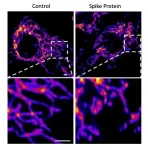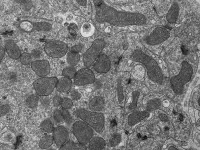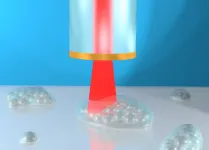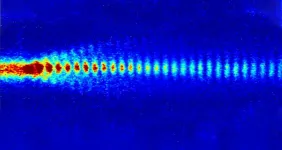(Press-News.org) LA JOLLA--(April 30, 2021) Scientists have known for a while that SARS-CoV-2's distinctive "spike" proteins help the virus infect its host by latching on to healthy cells. Now, a major new study shows that they also play a key role in the disease itself.
The paper, published on April 30, 2021, in Circulation Research, also shows conclusively that COVID-19 is a vascular disease, demonstrating exactly how the SARS-CoV-2 virus damages and attacks the vascular system on a cellular level. The findings help explain COVID-19's wide variety of seemingly unconnected complications, and could open the door for new research into more effective therapies.
"A lot of people think of it as a respiratory disease, but it's really a vascular disease," says Assistant Research Professor Uri Manor, who is co-senior author of the study. "That could explain why some people have strokes, and why some people have issues in other parts of the body. The commonality between them is that they all have vascular underpinnings."
Salk researchers collaborated with scientists at the University of California San Diego on the paper, including co-first author Jiao Zhang and co-senior author John Shyy, among others.
While the findings themselves aren't entirely a surprise, the paper provides clear confirmation and a detailed explanation of the mechanism through which the protein damages vascular cells for the first time. There's been a growing consensus that SARS-CoV-2 affects the vascular system, but exactly how it did so was not understood. Similarly, scientists studying other coronaviruses have long suspected that the spike protein contributed to damaging vascular endothelial cells, but this is the first time the process has been documented.
In the new study, the researchers created a "pseudovirus" that was surrounded by SARS-CoV-2 classic crown of spike proteins, but did not contain any actual virus. Exposure to this pseudovirus resulted in damage to the lungs and arteries of an animal model--proving that the spike protein alone was enough to cause disease. Tissue samples showed inflammation in endothelial cells lining the pulmonary artery walls.
The team then replicated this process in the lab, exposing healthy endothelial cells (which line arteries) to the spike protein. They showed that the spike protein damaged the cells by binding ACE2. This binding disrupted ACE2's molecular signaling to mitochondria (organelles that generate energy for cells), causing the mitochondria to become damaged and fragmented.
Previous studies have shown a similar effect when cells were exposed to the SARS-CoV-2 virus, but this is the first study to show that the damage occurs when cells are exposed to the spike protein on its own.
"If you remove the replicating capabilities of the virus, it still has a major damaging effect on the vascular cells, simply by virtue of its ability to bind to this ACE2 receptor, the S protein receptor, now famous thanks to COVID," Manor explains. "Further studies with mutant spike proteins will also provide new insight towards the infectivity and severity of mutant SARS CoV-2 viruses."
The researchers next hope to take a closer look at the mechanism by which the disrupted ACE2 protein damages mitochondria and causes them to change shape.
INFORMATION:
Other authors on the study are Yuyang Lei and Zu-Yi Yuan of Jiaotong University in Xi'an, China; Cara R. Schiavon, Leonardo Andrade, and Gerald S. Shadel of Salk; Ming He, Hui Shen, Yichi Zhang, Yoshitake Cho, Mark Hepokoski, Jason X.-J. Yuan, Atul Malhotra, Jin Zhang of the University of California San Diego; Lili Chen, Qian Yin, Ting Lei, Hongliang Wang and Shengpeng Wang of Xi'an Jiatong University Health Science Center in Xi'an, China.
The research was supported by the National Institutes of Health, the National Natural Science Foundation of China, the Shaanxi Natural Science Fund, the National Key Research and Development Program, the First Affiliated Hospital of Xi'an Jiaotong University; and Xi'an Jiaotong University.
About the Salk Institute for Biological Studies:
Every cure has a starting point. The Salk Institute embodies Jonas Salk's mission to dare to make dreams into reality. Its internationally renowned and award-winning scientists explore the very foundations of life, seeking new understandings in neuroscience, genetics, immunology, plant biology and more. The Institute is an independent nonprofit organization and architectural landmark: small by choice, intimate by nature and fearless in the face of any challenge. Be it cancer or Alzheimer's, aging or diabetes, Salk is where cures begin. Learn more at: salk.edu.
While the CRISPR-Cas9 gene editing system has become the poster child for innovation in synthetic biology, it has some major limitations. CRISPR-Cas9 can be programmed to find and cut specific pieces of DNA, but editing the DNA to create desired mutations requires tricking the cell into using a new piece of DNA to repair the break. This bait-and-switch can be complicated to orchestrate, and can even be toxic to cells because Cas9 often cuts unintended, off-target sites as well.
Alternative gene editing techniques called recombineering instead perform this bait-and-switch ...
Medical researchers at Flinders University have established a new link between high body mass index (BMI) and breast cancer survival rates - with clinical data revealing worse outcomes for early breast cancer (EBC) patients and improved survival rates in advanced breast cancer (ABC).
In a new study published in a top breast cancer journal- researchers evaluated data from 5 thousand patients with EBC and 3496 with ABC to determine associations between BMI and survival rates across both stages.
Researchers say the results present an 'obesity paradox' which will impact the survival outcomes of the 19,807 women and 167 men diagnosed with breast cancer in Australia in 2020.
Natansh Modi, a NHMRC PHD Candidate at Flinders University, says understanding the ...
The Brazilian Amazon rainforest released more carbon than it stored over the last decade - with degradation a bigger cause than deforestation - according to new research.
More than 60% of the Amazon rainforest is in Brazil, and the new study used satellite monitoring to measure carbon storage from 2010-2019.
The study found that degradation (parts of the forest being damaged but not destroyed) accounted for three times more carbon loss than deforestation.
The research team - including INRAE, the University of Oklahoma and the University of Exeter - said large areas of rainforest were degraded or destroyed due to human activity and climate change, leading to carbon loss.
The findings, published in Nature Climate Change, also ...
Mitochondria are the energy suppliers of our body cells. These tiny cell components have their own genetic material, which triggers an inflammatory response when released into the interior of the cell. The reasons for the release are not yet known, but some cardiac and neurodegenerative diseases as well as the ageing process are linked to the mitochondrial genome. Researchers at the Max Planck Institute for Biology of Ageing and the CECAD Cluster of Excellence in Ageing research have investigated the reasons for the release of mitochondrial genetic material and found a direct link to cellular metabolism: when the cell's DNA building blocks are in short supply, mitochondria release their genetic material and trigger inflammation. ...
Scientists at the University of Nottingham have developed an ultrasonic imaging system, which can be deployed on the tip of a hair-thin optical fibre, and will be insertable into the human body to visualise cell abnormalities in 3D.
The new technology produces microscopic and nanoscopic resolution images that will one day help clinicians to examine cells inhabiting hard-to-reach parts of the body, such as the gastrointestinal tract, and offer more effective diagnoses for diseases ranging from gastric cancer to bacterial meningitis.
The high level of performance the technology delivers is currently only possible in state-of-the-art research labs with large, scientific instruments - whereas this compact system has the potential to bring it into clinical settings to improve patient care.
The ...
Successful navigation requires the ability to separate memories in a context-dependent manner. For example, to find lost keys, one must first remember whether the keys were left in the kitchen or the office. How does the human brain retrieve the contextual memories that drive behavior? J.B. Julian of the Princeton Neuroscience Institute at Princeton University, USA, and Christian F. Doeller of the Max Planck Institute for Human Cognitive and Brain Sciences in Leipzig, Germany, found in a recent study that modulation of map-like representations in our brain's hippocampal formation can predict contextual memory retrieval in an ambiguous environment.
The researchers developed a novel virtual reality navigation task in which human participants learned object positions in two different ...
The future of particle acceleration has begun. Awake is a promising concept for a completely new method with which particles can be accelerated even over short distances. The basis for this is a plasma wave that accelerates electrons and thus brings them to high energies. A team led by the Max Planck Institute for Physics now reports a breakthrough in this context. For the first time, they were able to precisely time the production of the proton microbunches that drive the wave in the plasma. This fulfills an important prerequisite for using the Awake technology for collision experiments.
How do you create a wave for electrons? The carrier substance for this is a plasma (i.e., an ionized gas in which positive and negative charges are separated). Directing a proton beam through ...
The human immune system comprises functionally specialised cellular defence mechanisms that protect the body against disease. These include the dendritic cells. Their main function is to present antigens to other immune cells, especially T cells, thereby activating a primary immune response. Dendritic cells are divided into Type 1 (DC1) and Type 2 (DC2) dendritic cells. Each type fulfils different functions: DC1 provide an immune response to bacteria and viruses, DC2 protect against fungal or parasitic infections. In a recent study conducted at MedUni Vienna's Institute of Cancer Research, researchers found that a particular group of proteins plays a major role in the development of Type 1 dendritic ...
WHAT:
In a mouse study, National Institutes of Health researchers have identified and mapped a diverse spectrum of motor neurons along the spinal cord. These neurons, which send and receive messages throughout the body, include a subset that is susceptible to neurodegenerative diseases. Created with a genetic sequencing technique, the atlas reveals 21 subtypes of neurons in discrete areas throughout the spinal cord and offers insight into how these neurons control movement, how they contribute to the functioning of organ systems and why some are disproportionately affected in neurodegenerative diseases.
The study ...
Researchers have developed a brain-like computing device that is capable of learning by association.
Similar to how famed physiologist Ivan Pavlov conditioned dogs to associate a bell with food, researchers at Northwestern University and the University of Hong Kong successfully conditioned their circuit to associate light with pressure.
The research will be published April 30 in the journal Nature Communications.
The device's secret lies within its novel organic, electrochemical "synaptic transistors," which simultaneously process and store information just like the human brain. The researchers demonstrated ...






